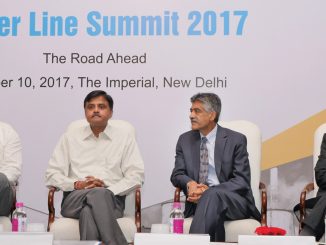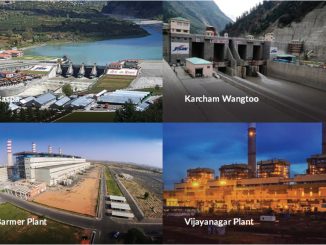 The increasing integration of wind and solar power into the Indian electricity grid poses challenges for reliable operations. Grid events broadly caused by transmission system faults external to or within a renewable energy plant, transmission system faults and overvoltage during line or reactor switching pose a serious threat to grid security as they can lead to cascading failures and loss of supply. Grid India’s recent report on Events Involving Transmission Grid Connected Wind & Solar Power Plant investigates 31 grid events associated with the frequent loss of renewable energy generation over the past year. Power Line presents key takeaways of the report…
The increasing integration of wind and solar power into the Indian electricity grid poses challenges for reliable operations. Grid events broadly caused by transmission system faults external to or within a renewable energy plant, transmission system faults and overvoltage during line or reactor switching pose a serious threat to grid security as they can lead to cascading failures and loss of supply. Grid India’s recent report on Events Involving Transmission Grid Connected Wind & Solar Power Plant investigates 31 grid events associated with the frequent loss of renewable energy generation over the past year. Power Line presents key takeaways of the report…
Between January 2022 and May 2023, 31 grid events occurred in the interstate transmission system (ISTS)-connected renewable energy pockets, resulting in generation losses ranging from 1,000 MW to 7,000 MW in individual events. Notably, disturbances causing a loss of 6-7 GW were observed in Rajasthan’s renewable energy complexes due to non-compliance during low voltage ride through (LVRT) and/or high voltage ride through (HVRT) events. Of the total 31 renewable energy-related events that occurred during the period January 2022 to May 2023, the report focuses on three major fault events for analysis. These events are chosen based on the severity or magnitude of generation-loss-initiating cause and phenomenon observed during the event, which are as follows:
- Multiple tripping of EHV lines and loss of more than 6,000 MW RE generation triggered by fault in 220 kV RE complex on August 11, 2022;
- Multiple tripping of EHV lines and loss of more than 3,000 MW RE generation triggered by phase-to-phase fault in 400 kV network on January 14, 2023; and
- Multiple tripping of EHV lines and loss of more than 3,000 MW renewable energy generation triggered due to the opening of the line reactor on February 9, 2023.
Notably, the report examines events related to large wind and solar pockets (ISTS-connected), while acknowledging the possibility of unnoticed incidents in smaller intra-state pooling stations due to limited visibility and minimal grid impact. The analysis is conducted sequentially, starting with the assessment of significant RE generation loss events using phasor measurement unit (PMU)/supervisory control and data acquisition and disturbance recorder (DR) data. Following this, simulation-based investigations leverage root mean square and electromagnetic transients’ tools to evaluate the sensitivity of different RE system components on the grid performance. The report also included field visits and interactions with various stakeholders, including renewable energy developers, original equipment manufacturers and other involved parties. The analysis-based PMU and DR data identifies that 31 events can be attributed to factors such as transmission system faults external to the renewable energy plant, transmission system faults within the renewable plant, overvoltage occurrences during line or reactor switching and forced oscillations in reactive power and voltage.
All such events pose a serious threat to grid security as they have a propensity to lead to cascade failures and supply loss in a wide area. An analysis of these events through measurement-based tools, simulation studies and interactions with stakeholders indicates several probable causes, viz., undesirable behaviour of inverter-based resources, low short-circuit ratio (SCR) in certain pockets, improper coordination of protection settings between renewable energy plants and the evacuating transmission system, non-compliance of the Central Electricity Authority’s (CEA) technical standards and inverter controller interactions, etc.
Suggestions for stakeholders
Considering the foreseen massive expansion of renewable energy resources in India, the investments involved, the short gestation period of such projects (18-24 months) vis-à-vis transmission commissioning (18-30 months) as well as the complex nature of grid interconnection studies involved (six months to one year), the report has put forth suggestions for stakeholders from long-term sustainability point of view.
Renewable energy equipment capability: The equipment associated with renewable energy plants including inverters/wind turbine generators (WTGs), inverter duty transformers, collector systems and transformers must be designed to handle the supply of rated MW and required MVAR under all ambient conditions at Indian sites. Voltage ride-through settings of inverters/WTGs and plant elements must be coordinated to enable the plant to withstand specified low/high voltages at the point of interconnection, factoring in the impact of intermediate equipment. Protection settings of inverters/WTGs should be coordinated to withstand extreme voltage limits at their terminals, as mandated by the CEA connectivity standards. The renewable energy equipment must be representable in simulation environments, with parameters and configurations featuring traceability to actual product models, variants and firmware versions. Inverters should have the capability to ride through momentary loss of synchronism conditions, modulating active and reactive currents during fault/transient periods to avoid undesirable operation of the protection system. Measuring instruments must record and archive high resolution data (1 ms or better), with renewable energy equipment capable of exporting data in standard readable formats upon the developer’s request.
Renewable energy loper: For renewable energy developers, ensuring the robust protection of inverter/WTG terminals and effective coordination with the PoI are paramount. The selection of appropriate renewable energy equipment plays a crucial role, requiring careful consideration of the specific project site conditions and adherence to grid connectivity standards. Additionally, the provision of high resolution disturbance recorder data is essential for comprehensive analysis and timely response to grid events. To enhance the resilience of the system, meticulous configuration of converter and plant control systems is advised. Moreover, strict compliance with cybersecurity guidelines is imperative to safeguard against potential cyberthreats and ensure a secure and reliable operation of renewable energy infrastructure. These measures collectively contribute to the seamless integration of renewable energy projects into the grid, promoting stability, reliability and adherence to industry standards.
Regulatory bodies: At the regulatory level, there is a need for the formulation of technical standards and regulatory frameworks to enable dynamic reactive power support from renewable energy plants during periods of nil active power generation while connected to the grid. Traditional SCR calculations should be revised to adequately consider the presence of nearby inverter-based resources and power electronic equipment. Adoption of metrics from IEEE Std 2800-2022, outlining power plant controller performance and coordination with inverters, is recommended, including parameters such as reaction time, rise time, overshoot and settling time. The coordination of inverter capabilities to meet these performance metrics should also be emphasised. Additionally, extending the applicability of existing CEA regulations for solar and wind resources to inverter-based energy storage systems and electrolysers is proposed. Strengthening regulatory mandates for high resolution data recording, retention, archival, extraction and sharing is crucial for facilitating post facto analysis of inverter-based resources and WTGs.
Institutional arrangements and capacity building: The establishment of a robust framework for testing and type certification of WTGs and inverter-based resources is imperative to ensure compliance with the CEA standards. In light of ambitious renewable energy integration targets, it is essential to develop and accredit agencies in India through CEA/National Institute of Wind Energy (NIWE)/National Institute of Solar Energy (NISE) for testing and certifying RE-related equipment deployed within the country. The proposed type test certification body will conduct individual equipment type tests, such as inverters and WTGs, assessing their compliance with the CEA standards. Upon meeting all unit-level requirements, the certification body will issue a statement of compliance and a type certificate for CEA standards.
Furthermore, an accredited certification body for renewable energy plants will benchmark both individual unit models and complete renewable energy plant models, issuing statements of compliance for each CEA standard requirement. To enhance simulation and testing capabilities in the renewable energy sector, a human resource development programme will be instituted by NISE/ NIWE, in collaboration with the CEA, CTU and Grid India. The personnel overseeing the operation of renewable energy plants will be required to obtain certification from the concerned authority.
Finally, a similar testing and certification framework will be developed and implemented in states rich in renewable energy resources, ensuring a standardised and comprehensive approach across the country.
Conclusion
To conclude, there is an urgent need for forward-looking technical standards and grid codes to accommodate emerging technologies in inverter-based resources, battery energy storage systems and hydrogen electrolysers. Given the complexity of India’s large power system, anticipating the behaviour of these new technological breakthroughs is essential to avoid potential challenges in retrofits. Ensuring high levels of compliance monitoring is vital, especially as advancements such as grid-forming inverters become necessary in the near future. Flexibility in standards is key, requiring extensive stakeholder consultations to establish a shared vision.
Overall, transmission planning emerges as a critical and challenging aspect, particularly with the integration of large solar parks, wind farms and energy storage. To manage variable and bidirectional power flows, the adoption of high voltage direct current and flexible alternating current transmission system devices is crucial. Incorporating traditional and new technologies such as synchronous condensers, STATCOM and grid-forming inverters becomes imperative to maintain inertia, handle short-circuit power and reactive power and provide black start facilities. In navigating these advancements, adaptability and a collaborative approach are paramount for the sustainable evolution of India’s power grid.



